

STARUML PERT SOFTWARE
Indeed, tens of different UML tools have been available today for practitioners’ use and offer various facilities for easing the software analysis, design, and development.
STARUML PERT CODE
This popularity is essentially due to UML's huge tool support, which enables the use of UML for modelling software systems and performing many other operations such as code generation, analysis, large view modelling, tool extension, multi-user collaboration etc. UML is nowadays considered as one of the most popular software modelling languages in the industry. That is, the structural modelling diagrams have been extended with the composite structure and package diagrams, and the behaviour modelling diagrams extended with new interaction overview and timing diagrams. With the release of UML's version 2.x in the 2000s, the existing UML diagrams have been revised and some new diagram types have been introduced. The system structures can be modelled with UML's use-case, class, object, component, and deployment diagrams, while the system behaviour can be modelled with UML's sequence, collaboration, activity, and state-machine diagrams. UML's diagrams can be classified into static and dynamic diagrams where the former represents the system structure modelling and the latter represents the system behaviour modelling. Unified Modelling Language (UML) has been announced by the object management group (OMG) in the late 1990s as a general-purpose software modelling language that offers a huge set of visual diagrams for modelling the software system requirements, architecture, and design at different levels of abstractions. The results will be helpful for practitioners in choosing the right tool(s) and the tool developers in determining the weaknesses/strengths. The analysis results reveal important findings: (i) 11 UML tools support multiple viewpoints, (ii) 17 tools support large-viewpoint management, (iii) Umple and Reactive Blocks support formal verification, (iv) 9 tools support the simulation of activity diagrams, (v) while 14 tools check pre-defined well-formedness rules, 8 of them support user-defined rules, (vi) 16 tools support scripting, (vii) 29 tools support code-generation and 18 of them support round-trip engineering, (viii) Java is the top popular language, (ix) 38 tools export UML models as image, 32 tools export as HTML, and 32 tools export as XML/XMI, (x) 17 tools enable versioning and 13 of them support multi-user access, (xi) 15 tools support the plug-in extensions and 12 tools support the IDE integration, (xii) 6 tools support project management, and (xiii) while most tools provide user-manuals, interactive guidance is rarely supported. In this study, 58 UML tools have been analysed for modelling viewpoints, analysis, transformation & export, collaboration, tool integration, scripting, project management, and knowledge management. Unified Modelling Language (UML) is essentially a de-facto standard for software modeling and supported with many modeling tools.


IET Cyber-Physical Systems: Theory & Applications.IET Collaborative Intelligent Manufacturing.CAAI Transactions on Intelligence Technology.


 0 kommentar(er)
0 kommentar(er)
